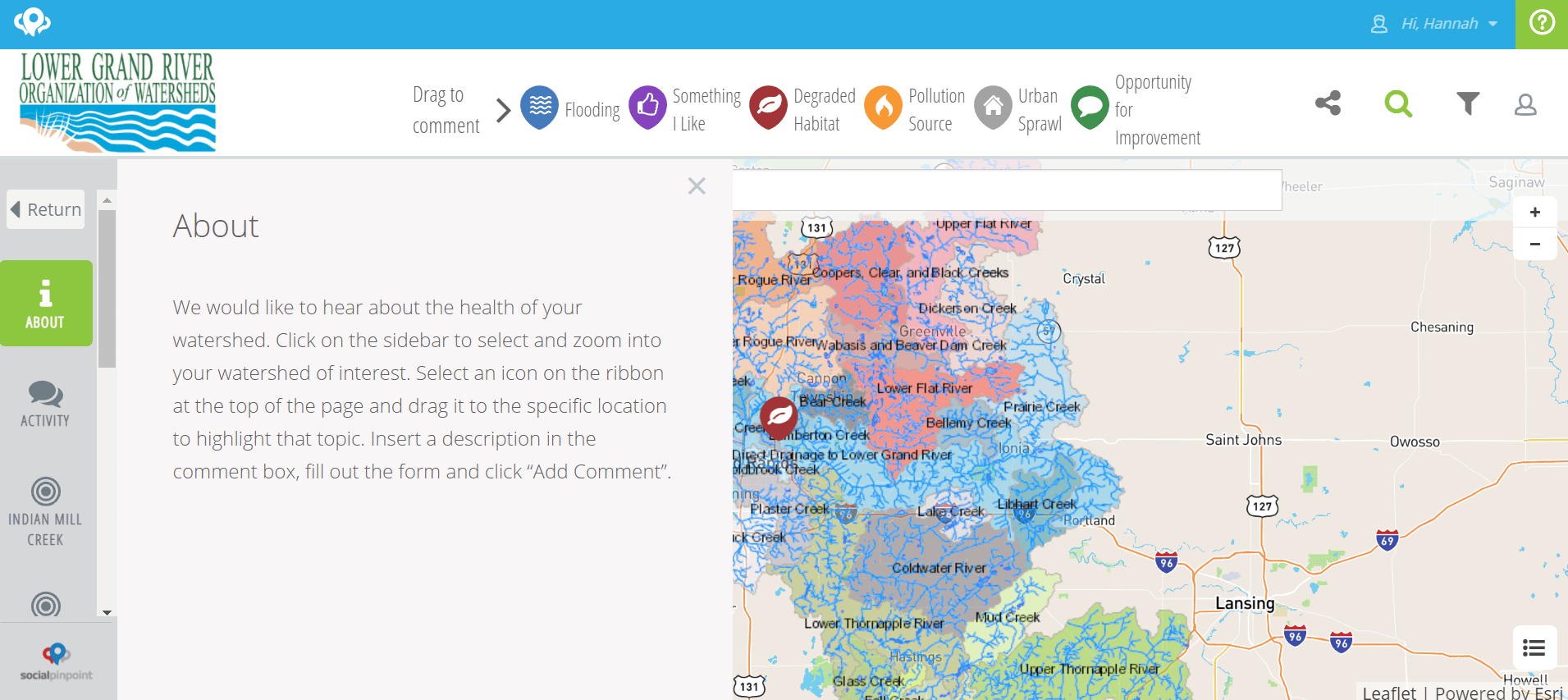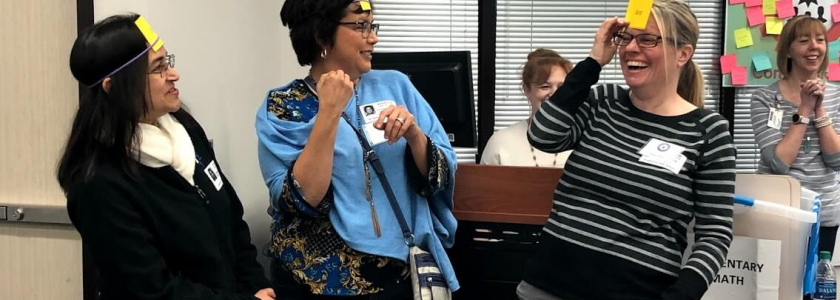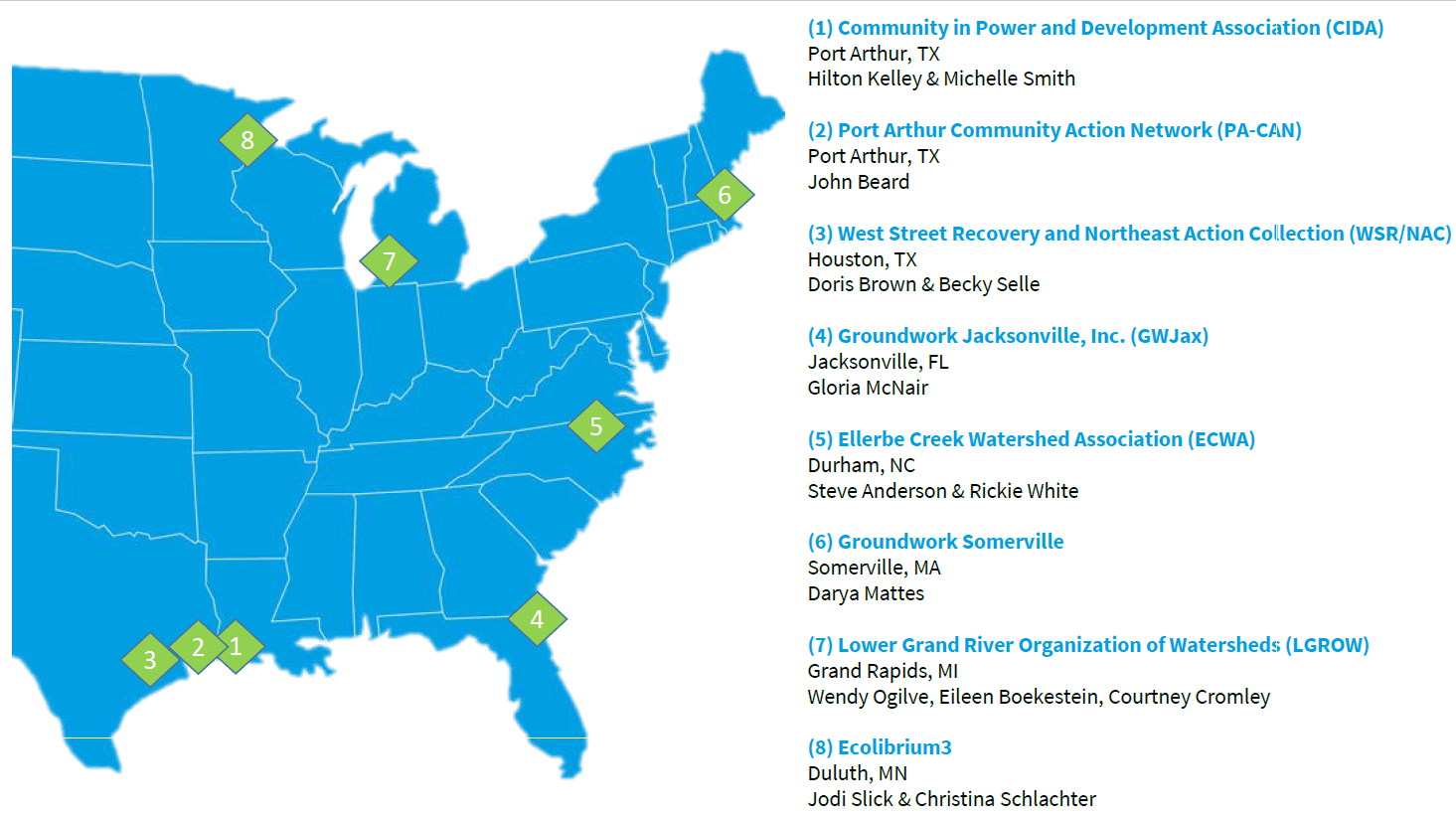Community-Led Research Projects Underway in 8 Communities: What Have We Learned?
River Network kicked off 2021 by granting 8 local organizations with funds and technical assistance to design and implement community-led research projects in their communities: the last eight months have been ripe with direct consulting, peer calls for our cohort of grantees, resource sharing, and research to support diverse projects. Community-led research, or CLR, is a strategy that centers genuine community engagement in collecting, analyzing, and putting to action locally sourced data. In our two-part toolkit series Tools for Equitable Climate Resilience, we introduce CLR as a solution for communities wanting to center equity in conversations and decisions around climate change impacts and climate resilience initiatives (as well as other issue areas). After spending nearly eight months working with organizations using CLR to address community concerns, River Network is excited to share grantees’ creative uses of this strategy, as well as their success stories and lessons learned.
Using CLR to Inform a Planning Process
Jacksonville, Florida
Groundwork Jacksonville (GW Jax) is involved in collecting community input in the development of the Emerald Trail, an asset that connects 14 neighborhoods to downtown and local waterways. The team from Groundwork focused in on three distinct neighborhoods that surround Hogan’s Creek and launched a community survey utilizing Question Pro, an online data collection and analysis tool. At first, survey responses were only representative of a predominantly white neighborhood; GW Jax adapted their survey strategy to include person-to-person canvassing in the communities of color that were not originally represented in the survey responses. By dispatching survey-takers into the community directly, they were able to collect 248 responses that more accurately represented all three neighborhoods near Hogans Creek. In response to the data collected, GW Jax is organizing three educational and informative walks to help community members build better relationships with local waterways, and taking community feedback to the Emerald Trail planning and design team and Steering Committee.
Grand Rapids, Michigan
Lower Grand River Organization of Watersheds (LGROW) is utilizing crowdsourced data collected through Social Pinpoint to understand the strengths, weaknesses, opportunities, and threats across the Lower Grand River Watershed —a huge watershed encompassing roughly 3,000 square miles. To better understand the local perspectives and interests across this vast area, LGROW is focusing on individual subwatersheds within the basin. After working with a steering committee of local representatives from two target subwatersheds, LGROW developed and launched an online platform that is open to the public for input. Via an online mapping exercise and an “idea wall” that collects general comments and concerns, LGROW is collecting data to inform the Lower Grand River Watershed Resilience Plan and respective action plans for specific communities. These hyper-local action plans will be given to local leaders in subwatersheds to provide direction and resources for improving resilience to climate change and other identified threats.

Port Arthur, Texas
In an effort to better inform a green stormwater infrastructure (GSI) pilot program, Community In-Power and Development Association (CIDA) is seeking to understand what types of GSI solutions community members are interested in and where frustrations currently exist. Using a hybrid approach of one-on-one interviews with residents and community meetings, CIDA learned there is a lot of frustration around how public funds are allocated and other “status quo” practices in Port Arthur. While the project was originally focused on GSI, a variety of needs-based conversations took priority in follow-up engagement sessions with residents. CIDA embraced this shift in discussion, noting that the community needed education on GSI before they could evaluate solutions, and are shifting their approach to accommodate conversations about intersecting needs and concerns to build trust and be a resource for other community concerns.
Using CLR to Change Policy & Secure Resources
Houston, Texas
After collecting 100 survey responses directly from community members about local flooding and associated impacts, West Street Recovery & Northeast Action Collective (WSR & NAC) analyzed their bilingual data set, ensuring it was available in both English and Spanish. As a horizontally organized grassroots effort, community-led research and the many stages of community engagement came naturally to these groups. Nearly 30 community members who engaged in the survey process appeared to give testimony at the Commissioners Court to report findings to local decision-makers and make the case for deeper financial investments in flood infrastructure. Representatives from WSR share: “This isn’t new information; we already knew these impacts and so does Council. Making this information stand out and leveraging it for real change is the next step.”
Port Arthur, Texas
Port Arthur Community Action Network (PACAN) is working in partnership with the Port Arthur’s Public Works Stormwater Drainage division to alter stormwater pathways in certain neighborhoods and reduce flooding. PACAN used a community survey to identify individuals to receive home air monitors and offered participants compensation for their time spent responding to the survey,. The air monitors are measuring the impact of mold and other air quality concerns exacerbated by residential flooding. With over 300 survey responses collected, PACAN is developing a representative case for investments in new stormwater and flood infrastructure in neighborhoods most affected by flooding. PACAN used a third-party to perform their data analysis, and are sharing the results back out to community members through a number of presentations and community meetings. They are informing the Public Works department to encourage future infrastructure investments. PACAN emphasizes the goal of CLR in all of their work: “Nothing about us, without us.”
Somerville, MA
Groundwork Somerville noticed that a particular neighborhood experiencing flooding wasn’t actually reporting impacts or incidents to the City of Somerville, resulting in a lack of action and investment in flood infrastructure in that area. The team at Groundwork responded by designing and distributing a survey, and dispatched members of their Green Team into the neighborhood to knock on doors and collect data from residents directly. One identified cause of increased flooding was paved-over alleyways that were previously unpaved and absorbed more stormwater. In response to this, and other identified causes and threats, Groundwork is organizing and facilitating walking tours of flood-prone neighborhoods for city councilors and other local decision-makers, to make the case for allocating specific funding for infrastructure projects that would alleviate flooding.
Durham, North Carolina
Similar to Groundwork Somerville, the Ellerbe Creek Watershed Association (ECWA) noticed there was a lack of flood data and reporting into their Urban Flooding Monitoring Program from the neighborhood surrounding Goose Creek in Durham. At the same time, residents of the neighborhoods near Goose Creek expressed great concern at worsening urban flooding issues in their area. While they assumed that flooding was occurring and going unreported, the mission of their CLR project is to ground-truth this assumption and look for ways to narrow the data gap. ECWA is assembling a Creek Watchers steering committee of local representatives to guide the design of their CLR project, and compensating participants with stipends. They are using GIS mapping to identify specific neighborhoods to survey, and sending out a team of paid survey-takers to collect data. ECWA plans to share their CLR data with City decision makers to make the case for more stormwater and flood infrastructure in the areas identified in their project.
Using CLR to Understand Relationships
Duluth, MN
Ecolibrium3 (Eco3) shifted the goals of their CLR project a few times in response to community feedback at various stages throughout the project design process. First launching an online crowdsourced survey, Eco3 was only able to gather five responses. Noting the number of community members who didn’t have in-home internet access, they shifted their approach to in-person surveying and re-tooled the questions they were asking. This shift resulted in a 90% participation rate for their survey team while gathering a plethora of perspectives on how community members relate to water. A second round of surveying resulted in a collection of photos of survey-takers, and a third round of data collection included in-person events and activities to better understand what they were learning about their community members. By implementing multiple stages of data collection, Eco3 was able to respond to feedback and alter their strategy to accommodate community concerns and interests. They are currently using the data and photos to assemble a mosaic of their community for public display, and informing their approach to public programming related to building climate-ready communities and other aspects of sustainability and resilience.
Looking Forward With CLR
Throughout the process of advising eight different CLR projects from extremely different cities across the country, we took note of some major lessons learned and recommendations for improving project outcomes:
- In-person interaction out-performs virtual strategies, especially when it comes to engaging communities of color and underrepresented segments of communities. Whether groups are/were using community mapping, surveys, interviews, or trying to crowdsource data, an in-person component resulted in increased response rates.
- The project process is just as important as the project results, as we saw in project partners’ shifting data collection strategies, goals, and actions. Creating space for the community to take ownership of the process is at the core of CLR as a practice, and embracing feedback and changing course led to trust-building and longer-term engagement from community members.
- Compensation continues to be a core component of equitable engagement, whether in the form of paid stipends, reimbursement for associated costs of participation (childcare, transportation), or directly provided services. CLR project teams compensated data collectors, data providers, and steering committee/planning team participants.
As River Network moves into the final stages of supporting these organizations, we see CLR as a key strategy and -tool for equitable climate resilience. By employing a CLR framework, organizations across the United States can get a holistic picture of their communities and develop programs in partnership with the people most impacted by climate change and lack of investment. If your organization is interested in developing a CLR project, we encourage you to reach out to our team about opportunities for financial and technical support.







[…] 2021, we supported 8 organizations exploring CLR, and provided project planning support through every stage of the process. Simultaneously, we […]
[…] climate change is critical and there is much that must and can be done to cut climate pollution and center communities in identifying solutions to adapt to existing harms. Still, this is another troubling decision and […]